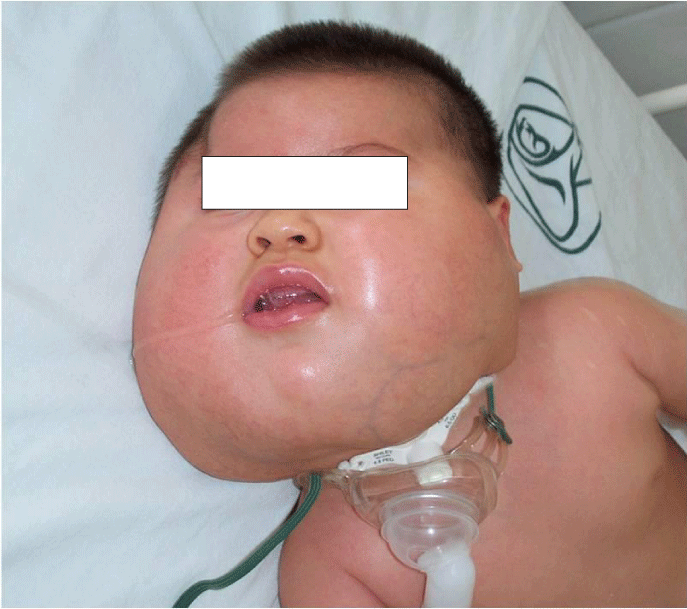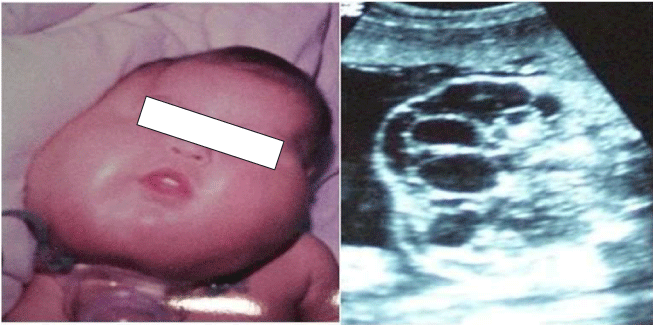Global Journal of Rare Diseases
Cowchock Wapner Kurtz Syndrome: Giant and Lethal Neck Cystic Hygroma: A Case Report
Avina Fierro JA1* and Hernandez Avina DA2
2Emergency Department, IMSS General Hospital 2, Aguascalientes, Mexico
Cite this as
Avina Fierro JA, Hernandez Avina DA (2017) Cowchock Wapner Kurtz Syndrome: Giant and Lethal Neck Cystic Hygroma: A Case Report. Glob J Rare Dis 2(1): 007-008. DOI: 10.17352/2640-7876.000006Cowchock Wapner Kurtz syndrome is a very rare disease and lethal disorder with cervical lymphangioma obstructing the airway and causing complications, with accelerated growth resembling a teratoma. We report a 21-month-old infant with a congenital giant neck cystic hygroma, cleft palatal and deformation of the surrounded area by lymphedema and tissue swelling; started with respiratory compromise because the expansion of the malformation, requiring repetitive surgeries without remission, showing recurrence and accelerated growth of the mass. It was used sclerotherapy with Picibanil, without satisfactory response; the patient suffered a rapid deterioration and dead. This is a rare syndrome of genetic etiology currently not clarified; apparently from healthy parents, and patient’s karyotype normal, maybe can be a micro deletion that only could be detected using advanced cytogenetics.
Introduction
Cystic hygroma is a rare disease with etiology unknown, this type of lymphangioma is different from the capillary and cavernous forms [1], it is a non-neoplastic cyst, caused by congenital malformation that often occurs in cervical region [2]. The origin is sequestration of primitive embryonic tissue in the jugular lymphatic sac, or from blocking of regional lymph drainage [3]. The mass has pattern of numerous dilated, thin-walled lymphatic channels interconnected cysts of varying size. Although they are benign, they can undergo progressive growth with compression and infiltration of adjacent structures [4]. Treatment is surgical excision and some cases need sclerotherapy.
Case Report
A 21-month-old male patient with the main manifestations of Cowchock Wapner Kurtz syndrome: giant neck cystic hygroma and cleft palatal that are the principal criteria for diagnosis. The family history was unremarkable; the marriage was non-consanguineous, the paternal aged was 43-year-old, the maternal age was 42-year-old; the parents were apparently healthy. The mother reported no exposure to drugs or teratogens during the pregnancy; the antenatal course was uncomplicated. The newborn was obtained from 37 weeks of gestation, in cesarean section because breech position and severe malformation of fetal cystic hygroma previously detected in prenatal ultrasound at 20 weeks of pregnancy. The newborn suffered neonatal hypoxia before and during birth; the birth weight was 3,250 g, length 48 cm, and head circumference 35 cm, the Apgar scores was 3 and 5; the physical examination showed the neck lymphatic malformation. Patient started with respiratory compromise because the rapid expansion of the malformation from 10 cm diameter to 13 cm, and surgery was performed at 5 days of age, with partial resection to remove most of the abnormal tissue. At the age of three months were performed tracheostomy and gastrostomy because the compression of the respiratory and digestive tracts was affecting the breathing and swallowing of the; at 11-month-old the patient needed gastric fundoplication to control severe gastro esophageal reflux. The magnetic resonance and imaging (MRI) of the lesion showed multiple well-defined cystic lesions homogenous and isointense. The new surgeries failed to achieve the stop the mass growth and it was started sclerotherapy with Picibanil (OK-432) in various treatments but without regression of the mass. The histological features were: multiple small cysts with numerous dilated, thin-walled vascular lymphatic channels and aggregates of connective tissue stroma.
The physical evaluation of the patient at 21-month-old showed weight 10 kg, height 77 cm, head circumference 46 cm, and a lymphatic malformation appeared as giant and soft, nonpulsatile mass with inflamed skin and vascular remodeling with a hyperpermeable, enlarged network of vessels with increased blood flow. The measure of size of the mass was 12 x 20 cm, with respiratory compromise and infiltration of the near areas like floor of the mouth, base of the tongue and pharynx, and the tumor was extended from the right side of the neck towards left side (Figure 1). The karyotype was normal, suggesting the possible existence of a microdeletion only distinguished with advanced cytogenetic techniques. Magnetic resonance imaging (MRI) revealed dense fluid containing a giant multicystic lesion extending from the right side of the neck (Figure 2).
Discussion
Cowchock Wapner Kurtz syndrome was first described in 1982 in two sib patients with cystic hygroma and cleft palatal from normal parents suggesting recessive inheritance; the lymphangioma had sporadic origin, no Turner or Noonan syndrome [5]. At the present time this syndrome is a very rare lethal disorder in patients with big cervical lymphangioma manifested by a giant neck mass that can obstruct the airway and cause complications in the feeding, showing and accelerated growth; although is a lymphatic malformation can resemble a cervical teratoma. The cystic lymphangioma is a rare malformation characterized by cystic structure deriving from detachment of lymph sacs from venous drainage systems; the cervical cystic hygroma is a benign congenital malformation of the lymphatic system [6]. Incidence of cystic hygroma is 1/6000 live births, but this lethal form is a rare phenotype; both genetic and environmental factors have been implicated in the etiology of this local aggressive lymphangioma with dependence on angiogenesis by the induction of new lymphatic capillaries from preexisting vessels. The magnetic resonance evaluation includes: number, size, signal intensities of the lesions, thickness of the septae, the configuration of the margins that are important in the evaluation of a cystic hygroma with accelerated growth [7]. Surgical treatment has a high rate of postoperative fluid re-accumulation and lesion recurrence resulting from incomplete resection; the next therapy in these cases is the postoperative adjuvant OK-432 sclerotherapy via closed suction drainage [8]. The Picibanil (OK-432) is produced by lyophilization of cultures of the low virulent strain of group A streptococcus pyogenes of human origin in lyophilized, incubated with benzyl penicillin [9], and has local antiangiogenetic properties; the early treatment of Picibanil in scleroteraphy of cystic hygroma has a long lasting and safe effect in the management [10].
We report a case of an infant with the clinical criteria of the syndrome: giant cervical cystic hygroma, cleft palatal and deformation of the surrounded area by lymphedema and tissue swelling. In this disorder the lymphatic mass had a very aggressive growth and the treatment was a great challenge using surgery and sclerotherapy but unfortunately the patient died. This case is illustrative of Cowchock Wapner Kurtz syndrome, rare disorder of genetic etiology currently not clarified. The parents are apparently healthy, and patient’s karyotype was normal, but can be a small micro deletion only distinguished with cytogenetic technique like “fluorescence in situ hybridization” (FISH). Parents are in advanced age and have decided better try the chance to adopt a child in the future.
- Zhang X, Gu Y, Lu L, Sun Y, Wang Y, et al. (2014) Clinicopathologic features of fetal nuchal cystic hygroma: report of 40 cases. Zhonghua Bing Li Xue Za Zhi 43: 173-176. Link: https://goo.gl/sXvHKs
- Ha J, Yu YC, Lannigan F (2014) A review of the management of lymphangiomas. Curr Pediatr Rev 10: 238-248. Link: https://goo.gl/1jk2tW
- Kumar N, Kohli M, Saumya Pandey S, Tulsi SPS (2010) Cystic hygroma. Natl J Maxillofac Surg 1: 81-85. Link: https://goo.gl/bpI6Ja
- Noia G, Pellegrino M, Masini L, Visconti D, Manzoni C, et al. (2013) Fetal cystic hygroma: the importance of natural history. Eur J Obstet Gynecol Reprod Biol 170: 407-413. Link: https://goo.gl/nvl3QG
- Cowchock FS, Wapner RJ, Kurtz A, Chatzkel S, Barnhart JS Jr, et al. (1982) Brief clinical report: not all cystic hygromas occur in the Ullrich-Turner syndrome. Am J Med Genet. 12: 327-331. Link: https://goo.gl/7occLV
- Gaddikeri S, Vattoth S, Gaddikeri RS, Stuart R, Harrison K, et al. (2014) Congenital cystic neck masses: embryology and imaging appearances, with clinicopathological correlation. Curr Probl Diagn Radiol 43: 55-67. Link: https://goo.gl/r1svRc
- Koelblinger C, Herold C, Nemec S, Berger-Kulemann V, Brugger PC, et al. (2013) Fetal magnetic resonance imaging of lymphangiomas. J Perinat Med 41: 437-443. Link: https://goo.gl/vF3EpO
- Knipping S, Goetze G, Neumann K, Bloching M (2007) Sclerotherapy of cervical cysts with Picibanil (OK-432). Eur Arch Otorhinolaryngol 264: 423-427. Link: https://goo.gl/mBZ7en
- Weitz-Tuoretmaa A, Rautio R, Valkila J, Keski-Säntti H, Keski-Nisula L, et al. (2014) Efficacy of OK-432 sclerotherapy in treatment of lymphatic malformations: long-term follow-up results. Eur Arch Otorhinolaryngol 271: 385-390. Link: https://goo.gl/r3u4LP
- Kim SY, Lee S, Seo JM, Lim SY (2015) Postoperative adjuvant OK-432 sclerotherapy for treatment of cervicofacial lymphatic malformations: an outcomes comparison. Int J Pediatr Otorhinolaryngol 79: 570-575. Link: https://goo.gl/YgJbQ3

Article Alerts
Subscribe to our articles alerts and stay tuned.
 This work is licensed under a Creative Commons Attribution 4.0 International License.
This work is licensed under a Creative Commons Attribution 4.0 International License.


 Save to Mendeley
Save to Mendeley
